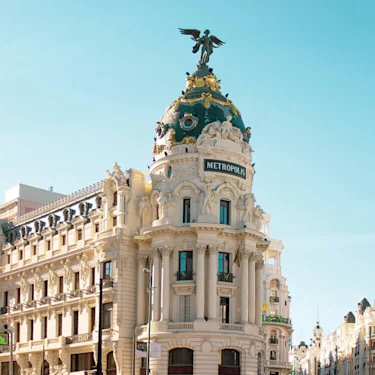
MAD
Travel
Out of Office
Destination: Madrid
Theme: Places
Words by Jennifer Leigh Parker
Photos courtesy Unsplash
Madrid is having a moment. Though this imperial city still bears the scars of the European debt crisis and the crushing effects of COVID, it’s coming out of the gate like a pent-up bull.
The city of Madrid is spending 13 million euros this year with the aim of becoming “one of the world’s top city destinations,” according to the tourism bureau. They’re off to a running start: In July 2022, Spain welcomed 9.1 million international tourists, which is more than double than in the same month in 2021, according to the National Statistics Institute.
Many in the hospitality industry saw this coming and prepared for it. Back in 2020 when the world stopped traveling, Madrid was littered with distressed properties looking to sell. Hotels were shuttered and real estate was cheap. Seizing the opportunity, real estate developers — with and without prior plans to invest — swooped in and rebuilt in such a spectacular fashion, even the boulevards seem to have a brand-new shine.
In the heart of the city, historic landmark buildings and architectural marvels have reopened their doors as hotels and are rapidly becoming social hot spots. Setting the tone are the Rosewood Villa Magna, the Mandarin Oriental Ritz, the Four Seasons Hotel Madrid and a new outpost of the Marriott-owned Edition — each of which received multimillion-dollar redesigns within the past three years. More openings are coming. Madrid currently hosts 803 hotels, with 15 more slated to open by 2024, including buzz-worthy brands like Thompson, Sonder and Nobu.
Though Madrid was once seen as a stopover to other, more popular coastal attractions, such as Barcelona or Mallorca, that perception is changing. Madrid is known for modern connectivity; its massive high-speed rail network called Alta Velocidad Española (AVE) is second in length only to the tracks in China, and its international Madrid-Barajas Airport is the second-largest airport in Europe.
Now, instead of a place to pass through, Madrid is giving us more reasons to stay. Here are just a few of the not-to-miss highlights:
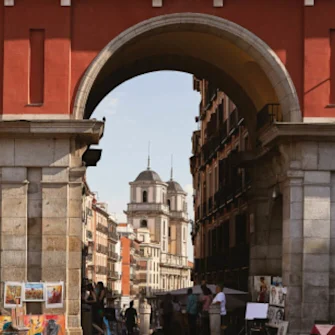
Plaza Mayor, Madrid. Photography Unsplash
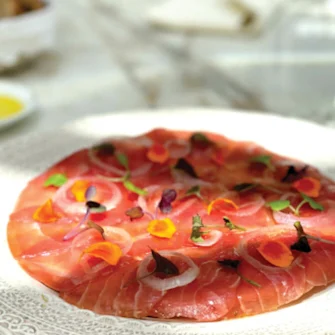
Palm Court, Mandarin Oriental, Madrid
Eat
“Nobody goes to bed in Madrid until they have killed the night,” wrote Ernest Hemingway in Death in the Afternoon (1932). This is no less true today. Dinner is a late affair, with friends and families typically gathering at the table around 10 p.m.
On weekends, the lead-up to dinner involves a Spanish tapas bar crawl, which can last until morning. Locals call this ritual “tardeo,” and its fullest expression can be found on a colorful, festive street called Calle de la Cava Baja. No reservations are required, just an ambling attitude and an adventurous palate.
Amós
For a fancy fine-dining experience, head to Amós, led by Michelin-starred chef Jesús Sánchez. Here, locals don their finest attire to carouse over the course of an eight-plate prix fixe menu that showcases Cantabrian cuisine from the northern coast of Spain.
It’s a gastronomic performance, staged in a dining room furnished with spacious banquettes, royal-blue velvet chairs and soft gold pendant lighting. The show begins with tiny bites, like a quarter-sized anchovy sphere, which leads to a few spoonfuls of pickled-mussel pâté before an entr’acte of small plates featuring caramelized foie gras on black-olive sponge cake — all of which crescendos to the main dish: a fall-apart hake filet swimming with Cantabrian cockles in a pool of delicious green sauce.
And if you have any room left, tuck into the almost too-divine-to-eat assortment of desserts, such as almond cake with caramel ice cream or a cloud of white-chocolate cream topping seasonal fruits.
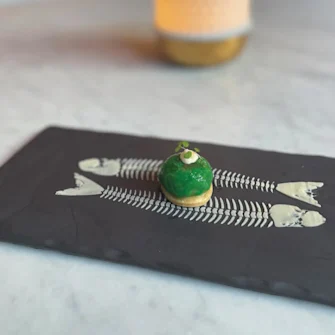
Amós Restaurant, Photo by Jennifer Leigh Parker
Dani Brasserie
There are a few eateries you really should not miss. Dani, on the rooftop of the Four Seasons hotel, is one of them. Cut through the lobby and take the elevator to the seventh floor. There awaits one of the best views of the city, beneath a glorious 19th-century bell tower perched at the precipice. Stand here and watch all the grand boulevards and historic monuments of Madrid sprawl out before you, illuminated by the city lights.
Madrileños adore this spot, too. They come for the views, but also for the excellent craft cocktails, tapas and full Andalusian menu, the creation of Spanish chef Dani García. If you’re in the mood to snack on acorn-fed ibérico ham, pick apart a rosette of bluefin tuna or photograph the edible flowers in your cocktail, this is the place to satisfy your cravings.
Stay
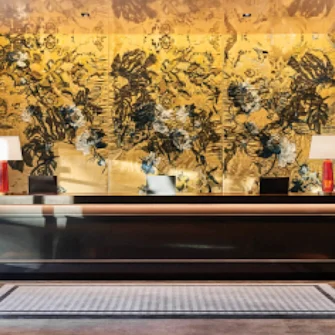
Rosewood Villa Magna, Madrid, Front Desk.
Mandarin Oriental Ritz, Madrid
After a three-year renovation, this gilded dame has been restored to her circa-1910 grandeur. This is largely thanks to the work of Spanish architect Rafael de La-Hoz Castanys and French interior design agency Gilles & Boissier. Most strikingly, the great steel and glass dome above the Palm Court restaurant, which had been hidden for 80 years, has been recovered — bringing blue sky and natural light into the social heart of the 153-room hotel.
It’s everything you might expect from a Mandarin Oriental in a major metropolis. Sophisticated refinery broadly nods to Anglo-Saxon, European and Asian cultures, which is a delicate balancing act. But they are rewarded for it with strong brand loyalty. Regulars can expect proper English afternoon-tea service set to live piano music, gold-leaf accents adorning the delicate desserts and an ultra-luxe Champagne and tapas bar that seats only eight. And that’s just the restaurant.
This classic property manages to stay contemporary because it’s self-aware. Management knows the median age of their wealthy clientele, and they’re working to attract the next generation of travelers, who don’t want to stay cosseted in goose-down bedchambers — they want to be out discovering Madrid! Peruse the hotel’s Instagram account and you’ll find promoted “MOExperiences,” which include private museum tours (the Prado is steps away), visits to the Liria Palace and day-trip itineraries that highlight the city’s best gourmet markets, art galleries, clubs, restaurants and shops. This kind of golden-key access is what you should expect from a five-star concierge, and this staff does not disappoint.
Rosewood Villa Magna
Some hotels envelop you in their world and color your impressions of a destination. Rosewood Villa Magna is one of those. Built on the site of the 19th-century Anglada Palace, it first opened as a hotel in 1972 and attracted Spanish aristocrats. Following a 210 million euro investment by RLH Properties, the 154-room building underwent extensive renovations led by Spanish architect Ramón de Arana and reopened in October 2021.
Today, the hotel still evokes a sense of royalty, with an aged-brass façade that reflects the sun and a white stone porte-cochère entrance that opens onto a spectacular garden courtyard, which you can see from the comfort of your hotel room. The Villa Magna suite, for example, overlooks the Paseo de la Castellana boulevard and features a king-size bedroom with a writing desk and chaise lounge, a marble bathroom and a luxurious living room flanked by a breakfast table and in-room bar.
But it’s the smaller details that make it memorable. A copy of painter Francisco Goya’s biography sits on the foyer table. Fresh flowers have been placed in each room. The bar is stocked with crystal glassware, plus a gin-and-tonic kit with all the trimmings. Even the fine linen pillow has your initials embroidered onto it. If that doesn’t make you feel welcome, I don’t know what will.
Play
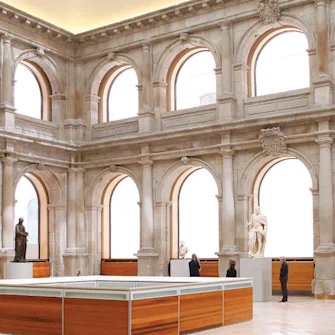
Hall of the Cloister of the Prado Museum. Agustín Martínez © Madrid Destino
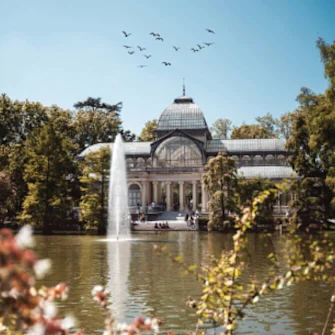
Museo del Prado
Madrid is an art lover’s capital, with countless galleries and museums to choose from; but its most revered treasures can be found along the Paseo del Prado. Like nowhere else, it is within the walls of the hallowed Museo del Prado that one gets a sense of the Spanish soul.
If you listen closely, the artists and artworks in this 200-plus-year-old institution can tell you much about their patron monarchs, who are inextricably linked to the history of Spain.
Here, you’ll find the world’s most comprehensive collection of Spanish master painters Diego Velázquez and Francisco Goya, who are presented with such clarity that their lives seem to come through the canvas. Their paintings reflect not just royal court concerns, but historical upheavals, and their respective styles influenced the artists who came after them.
Beyond the Spanish masters, you’ll also get a master class in European art, thanks to the Prado’s extraordinary collection of Rubens, Rembrandt, Bosch and Titian. With thousands of paintings, drawings, prints and sculptures to see, you’ll want to spend at least a few hours meandering through the wings. To keep things fresh, the museum also hosts a slate of new exhibitions throughout the year.
El Retiro Park
El Retiro is to Madrileños what Central Park is to New Yorkers, or the Luxembourg Gardens is to Parisians. It’s the place everyone comes to relax, play and enjoy a respite from urban life. For starters, it’s a massive green space, spanning approximately 350 acres in the city center, with gardens and statues as glorious as any you’ll find in a European capital.
The focal meeting point is a large artificial lake, watched over by the imposing stone Monument to Alfonso XII, complete with an equestrian sculpture of the king. It’s a popular spot to rent rowboats and listen to street musicians as you watch the world go by.
Lastly, don’t miss the Palacio de Cristal, aka the Glass Palace. Hidden among the trees south of the lake, this glass pavilion was built in 1887 as a winter garden for exotic flowers. It is one the finest examples of cast-iron architecture in Spain.